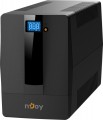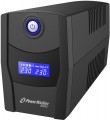Switching to battery
The time required to transfer the load from mains power to battery power. In standby and
interactive UPSs (see Type), a short-term power failure occurs at this moment — accordingly, the shorter the time to switch to the battery, the more uniform the power supply is provided by the source during a power failure. Ideally, the switching time for the traditional 50 Hz AC frequency should be less than 5 ms (a quarter of one cycle of the sine wave). With inverter UPSs, the transfer time is, by definition, zero.
Input voltage range
In this case, the input voltage range is implied, in which the UPS is able to supply a stable voltage to the load only due to its own regulators, without switching to the battery. For redundant UPSs (see "Type") this range is quite small, approximately 190 to 260 V; for interactive and especially inverter ones, it is much wider. Some UPS models allow you to manually set the input voltage range.
Efficiency
Efficiency (coefficient of performance) in the case of a UPS is the ratio of its output power to the power consumed from the network. This is one of the main parameters that determine the overall efficiency of the device: the higher the efficiency, the less energy the UPS wastes (due to heating parts, electromagnetic radiation, etc.). In modern models, the efficiency value can reach 99%.
Redundant sockets
The number of
outlets connected to the power reserve(battery) provided in the design of the UPS. In order for the UPS to fulfill its main role (providing a backup power in case of power outages), the corresponding electrical appliances must be connected to these outlets. The sockets have a standard shape and are compatible with the vast majority of popular 230 V plugs.
At a minimum, the UPS has
1 or
2 outlets and, in more advanced ones, there may be
3 or
more.
Total battery capacity
The capacity of the battery installed in the UPS. For models with multiple batteries, this is both the total working capacity and the capacity of each individual battery: the batteries in such devices are usually connected in series, so that their total capacity corresponds to the capacity of each individual cell.
Theoretically, a higher battery capacity means the ability to power loads of a given capacity for longer. However, in fact, this parameter is more of a reference than practically significant. The fact is that the actual amount of energy stored by the battery depends not only on the capacity in amp-hours, but also on the voltage in volts; this voltage is often not specified in the characteristics, despite the fact that for accurate calculations it must be known. So when choosing, you should focus on more "close to life" characteristics — first of all, on the directly claimed operating time in different modes (see above).
Number of batteries
The number of batteries supplied with the UPS.
In general, this parameter is more of a reference than practically significant: the number of batteries is selected in such a way as to provide the desired performance — primarily the time of continuous operation. First of all, it is worth paying attention to such characteristics when choosing.
Battery type
The type of battery installed in the UPS.
—
Fiberglass (AGM). An advanced type of lead-acid battery with electrolyte in an adsorbed state: the compartments of such a battery are filled with porous material, which contains acid. At the same time, the battery case is sealed and AGM models are maintenance-free. This technology is the most popular in batteries for uninterruptible power supplies: it is ideal for batteries operating in buffer mode (that is, when they rarely need to be discharged and, as a rule, little by little). In addition, it provides a long service life, and AGM batteries are inexpensive. The disadvantages of this option include the impossibility of replenishing the electrolyte if it leaks, as well as poor tolerance to overcharging (although the latter becomes irrelevant with a high-quality power controller).
—
Gel (GEL). A type of lead-acid battery that uses a gel electrolyte. GEL batteries are best suited for operation in cyclic mode - that is, when the battery needs to power the load for a long time, discharge almost to zero, then charge and again provide long-term autonomous power. But for the buffer mode, in which most UPSs operate (standing on standby for a long time in order to briefly maintain power supply in the event of a failure), this technology is not suitable for a number of reasons. Therefore, it makes sense to purchase such batteries only in cases where t
...he “uninterruptible power supply” has to be turned on almost every day - for example, in unstable networks with constant and long-term power outages.
— Lithium-ion (Li-Ion). The key advantages of lithium-ion batteries are high capacity with small dimensions and weight. Also, Li-Ion batteries are not subject to the “memory effect” and can charge quite quickly. Of course, this option is not without its drawbacks - first of all, it is sensitive to low and high temperatures, and if overloaded, the lithium-ion battery can catch fire or even explode. However, thanks to the use of built-in controllers, the likelihood of such “emergency” situations is extremely low and, in general, the advantages of this technology significantly outweigh the disadvantages.
— Lithium iron phosphate (LiFePO4). An advanced modification of lithium-ion batteries (see above), designed to eliminate some of the shortcomings of the original technology. Lithium iron phosphate batteries are characterized by a large number of charge/discharge cycles, chemical and thermal stability, low temperature tolerance, short charging time (including high currents) and safety in operation. The likelihood of an “explosion” of a LiFePO4 battery when overloaded is reduced to almost zero, and in general, such batteries cope with high peak loads without problems and maintain the operating voltage almost until they are fully discharged.Full charge time
The time it takes to fully charge the UPS battery. Note that in this case, this time is calculated according to special rules: not from 0 to 100% of the charge, but from a state in which it is impossible to maintain half the load, up to 90% of the charge. Of course, a full charge will take a little longer. However, this data is closer to practice than the “from 0 to 100%” calculation: the inability to work at half load makes the UPS practically useless, and this condition can be taken as zero, and 90% of the battery is already able to provide a good guarantee in case of a power failure.
Max. charging current
The maximum current in Amperes that charges the UPS battery or battery pack. Frequent charging cycles with high currents reduce the battery's service life. However, charging in this mode will come in handy during regular power outages - it makes sense to use
high charging currents when you need to charge the batteries as quickly as possible while the power is on and be fully prepared for the next power outage.

